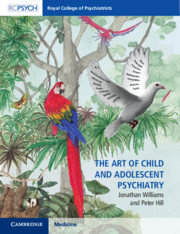1295 results

The Art of Child and Adolescent Psychiatry
- Coming soon
-
- Expected online publication date:
- August 2024
- Print publication:
- 30 June 2024
-
-
Part of:
- Children's Mental Health Collection
-
- Book
- Export citation
32 - January 1740. Cleland to Christopher Mole
- from The Correspondence
-
- Book:
- The Cambridge Edition of the Correspondence of John Cleland
- Published online:
- 25 May 2024
- Print publication:
- 13 June 2024, pp 102-103
-
- Chapter
- Export citation
50 - 13 November 1749. Examination of Ralph Griffiths before Lovel Stanhope for Publishing Memoirs of a Woman of Pleasure
- from The Correspondence
-
- Book:
- The Cambridge Edition of the Correspondence of John Cleland
- Published online:
- 25 May 2024
- Print publication:
- 13 June 2024, pp 144-145
-
- Chapter
- Export citation
68 - [c. 20] January 1753. Cleland to Edward Dickinson
- from The Correspondence
-
- Book:
- The Cambridge Edition of the Correspondence of John Cleland
- Published online:
- 25 May 2024
- Print publication:
- 13 June 2024, pp 177-178
-
- Chapter
- Export citation
101 - 16 May 1763. Cleland to Thomas Pichon
- from The Correspondence
-
- Book:
- The Cambridge Edition of the Correspondence of John Cleland
- Published online:
- 25 May 2024
- Print publication:
- 13 June 2024, pp 263-264
-
- Chapter
- Export citation
116 - 18 January 1771. Cleland’s Note ‘On the Gin-seng’
- from The Correspondence
-
- Book:
- The Cambridge Edition of the Correspondence of John Cleland
- Published online:
- 25 May 2024
- Print publication:
- 13 June 2024, pp 304-308
-
- Chapter
- Export citation
34 - 18 July 1740. Cleland to William Frederick Boscawen, Richard Wood, and Feilder Freeman
- from The Correspondence
-
- Book:
- The Cambridge Edition of the Correspondence of John Cleland
- Published online:
- 25 May 2024
- Print publication:
- 13 June 2024, pp 106-107
-
- Chapter
- Export citation
113 - 15 February 1769. Sylas Neville’s Diary Entry
- from The Correspondence
-
- Book:
- The Cambridge Edition of the Correspondence of John Cleland
- Published online:
- 25 May 2024
- Print publication:
- 13 June 2024, pp 300-300
-
- Chapter
- Export citation
8 - 7 December 1734. Cleland to Henry Lowther
- from The Correspondence
-
- Book:
- The Cambridge Edition of the Correspondence of John Cleland
- Published online:
- 25 May 2024
- Print publication:
- 13 June 2024, pp 44-45
-
- Chapter
- Export citation
58 - 27 November 1750. Letter from the Duke of Newcastle to the Attorney General Urging Prosecution of Various Individuals
- from The Correspondence
-
- Book:
- The Cambridge Edition of the Correspondence of John Cleland
- Published online:
- 25 May 2024
- Print publication:
- 13 June 2024, pp 153-153
-
- Chapter
- Export citation
85 - 25 May 1757. Cleland to Thomas Pichon
- from The Correspondence
-
- Book:
- The Cambridge Edition of the Correspondence of John Cleland
- Published online:
- 25 May 2024
- Print publication:
- 13 June 2024, pp 216-219
-
- Chapter
- Export citation
131 - 13 April 1779. James Boswell’s Journal Entry
- from The Correspondence
-
- Book:
- The Cambridge Edition of the Correspondence of John Cleland
- Published online:
- 25 May 2024
- Print publication:
- 13 June 2024, pp 346-348
-
- Chapter
- Export citation
48 - 10 November 1749. Cleland to Andrew Stone ()
- from The Correspondence
-
- Book:
- The Cambridge Edition of the Correspondence of John Cleland
- Published online:
- 25 May 2024
- Print publication:
- 13 June 2024, pp 137-139
-
- Chapter
- Export citation
106 - 15 May 1765. Cleland to Thomas Pichon
- from The Correspondence
-
- Book:
- The Cambridge Edition of the Correspondence of John Cleland
- Published online:
- 25 May 2024
- Print publication:
- 13 June 2024, pp 272-273
-
- Chapter
- Export citation
The Correspondence
-
- Book:
- The Cambridge Edition of the Correspondence of John Cleland
- Published online:
- 25 May 2024
- Print publication:
- 13 June 2024, pp 29-357
-
- Chapter
- Export citation
10 - 13 December 1734. Henry Lowther to the Mayor and Council
- from The Correspondence
-
- Book:
- The Cambridge Edition of the Correspondence of John Cleland
- Published online:
- 25 May 2024
- Print publication:
- 13 June 2024, pp 48-52
-
- Chapter
- Export citation
49 - 13 November 1749. Cleland to Lovel Stanhope
- from The Correspondence
-
- Book:
- The Cambridge Edition of the Correspondence of John Cleland
- Published online:
- 25 May 2024
- Print publication:
- 13 June 2024, pp 140-144
-
- Chapter
- Export citation
56 - 20 March 1750. Examination of William Owen before Lovel Stanhope for Selling Memoirs of Fanny Hill
- from The Correspondence
-
- Book:
- The Cambridge Edition of the Correspondence of John Cleland
- Published online:
- 25 May 2024
- Print publication:
- 13 June 2024, pp 151-151
-
- Chapter
- Export citation
97 - 21 September 1762. Cleland to Edward Dickinson
- from The Correspondence
-
- Book:
- The Cambridge Edition of the Correspondence of John Cleland
- Published online:
- 25 May 2024
- Print publication:
- 13 June 2024, pp 254-256
-
- Chapter
- Export citation
67 - 16 January 1753. Cleland to Edward Dickinson
- from The Correspondence
-
- Book:
- The Cambridge Edition of the Correspondence of John Cleland
- Published online:
- 25 May 2024
- Print publication:
- 13 June 2024, pp 174-176
-
- Chapter
- Export citation



